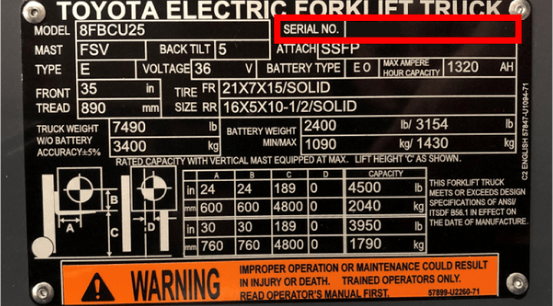Forklift Field Modifications Do’s And Don’ts

Between scratches, dents, and replaced parts, a forklift can undergo a lot of changes and repairs throughout its lifetime. Also, it’s common for customers to want to add additional features to a forklift after it arrives. How do you know for sure if the modification is acceptable or how it will ultimately affect your forklift’s safe operation? Here are a few helpful tips based on common misconceptions to help guide you down the right path.
ANSI B56.1 REGULATIONS
One common misconception is that you don’t need permission to make changes to a forklift. While it’s true that not all modifications require approval, per ANSI B56.1 Section 4.2.1, there are some that do:
“Except as provided in para. 4.2.2, no modifications or alterations to a powered industrial truck that may affect the capacity, stability, or safe operation of the truck shall be made without the prior written approval of the original truck manufacturer or its successor thereof. When the truck manufacturer or its successor approves a modification or alteration, appropriate changes shall be made to capacity plates, labels, tags, and operation and maintenance manuals.”
To put this paragraph in simpler terms, it is stating that if the modification could affect the truck’s lifting capacity, stability, or safe operation, then you should seek prior written approval from the truck manufacturer to make the change. If you’re ever unsure if a modification will require approval, make sure to work with your local, authorized Toyota dealer to confirm. They can also assist with ordering and installing new data plates as necessary.
Relatively quickly, you’ll need to know some quick information about your forklift’s capabilities. Luckily, a forklift data plate is installed on every truck on the market to help you understand what your forklift can do and provide vital information. Let me provide a guide that can help you read your data plate and start lifting better using all of the readily available information.
COMMON MODIFICATIONS IN THE FORKLIFT FIELD
- Drilling or cutting into the overhead guard or hood
- Changing attachments, forks, masts, or tire types
- Swapping counterweights
- Modifications that affect visibility
UNDERSTANDING THE UL RATING
Many forklifts conform to or are certified for a certain Underwriter’s Laboratory (UL) rating. There are also options available that modify a forklift to meet other UL rating standards so that they can be safely operated in certain types of environments. The UL rating certification verifies that the forklift and its configuration have been approved by UL to comply with these standards.
What many people don’t know is that any change to a forklift’s electrical, exhaust, or fuel system (among others) can void the UL rating of the truck. Changes as simple as swapping a wiring harness or installing a new strobe light can actually cause the forklift to no longer meet UL’s set standards. Fortunately, many items can be installed in the field by a Toyota technician without affecting UL classification.
If you need to replace an existing part, replacing it with the same manufacturer’s part as instructed by the manufacturer will typically not void the UL rating. For parts being added that aren’t replacing existing ones, it is important that the parts be approved by UL as a field installable option. Manufacturers of approved field installable options for forklifts can be found on UL’s website. These pre-approved parts are specific when it comes to the brand/model of the part and the forklift, so it’s important to pay attention to this prior to making any changes. Just because a part is “UL approved” or “UL listed” does not mean that installing it will not void the UL rating of your forklift.
Finally, if a part is being installed or a modification is being made that isn’t pre-approved, UL can send out a field representative to observe the modification being performed. They may also need to test the truck afterwards to determine if it meets their requirements and, if it passes, they can grant their approval for it to maintain the UL rating. For general UL related questions or to schedule a UL visit, you can contact them on their support line at 877-UL HELPS.
When in doubt, it’s best to verify with a professional who is knowledgeable on the subject prior to making any changes to your forklifts. Regardless of the change you are wanting to make, be sure to contact your local, authorized Toyota dealer for professional advice and support throughout the entire process.


